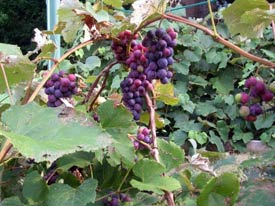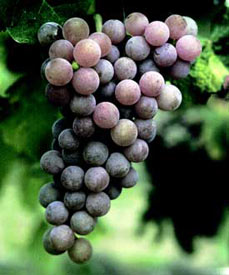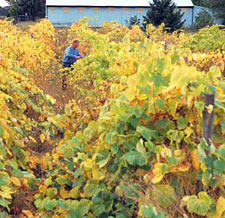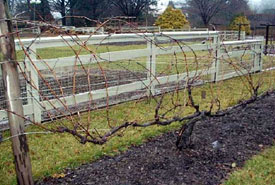
Table grapes are the perfect backyard crop. They require little space if trained properly, produce fruit the second year after planting, and can be eaten fresh, as juice, or in jams.
It's a wonder more home gardeners don't grow their own grape vines. Grapes have a reputation for being hard to care for, and their vigorous growth too weedy to handle. However, with proper pruning, your grapes can produce an abundance of fruit for the table and even for juice or wine making.
Grapes are prolific. The second year after planting they will produce fruit. In three years you'll get up to 15 pounds of fruit per vine. Two vines are probably enough to support a household of grape lovers.
Besides being easy to grow and prolific, grapes are also tasty and good for you. Not only are they a rich source of vitamins A, C, B6, and folate, they contain essential minerals like potassium, calcium, and iron. Grapes also are loaded with antioxidants, such as resveratrol, that may reduce the risk for Alzheimer's disease, heart disease, and cancer. So, grow a few vines of grapes in the backyard for fresh eating and, if you're ambitious, for making a little wine and juice, too. Here's how.

'Pink Reliance' table grape is a seedless variety that can grow in cold-weather areas. It has attractive pink new shoots in spring.
Grapes are broken into three general groups. American grapes (Vitis lambrusca) are the most cold hardy (to USDA zone 4) and most widely adapted of the grape species. European grapes (Vitis vinifera) grow best in sunny climates with warm summers and mild winters, such as in California. They are only hardy to USDA zone 7. Crosses between these two groups and with other lesser species abound. Many of these hybrids are adapted to cold climates, allowing vineyards to sprout up in places normally too cold to produce wine grapes. In the South, the muscadine grape (Vitis rotundifolia) is a native, vigorous vine that adapts well to the heat and humidity. It's hardy to USDA zone 7 and can produce up to 30 pounds of fruit a year when mature.
There are hundreds of grape varieties to choose from. Some varieties take a long time to mature or have limited hardiness, so be sure to select ones adapted to your climate. Some muscadine varieties are self-fertile, while others need a pollinator to produce. Here are some of the most popular grape varieties to try in your garden.

A grape field, with its bright yellow fall foliage, can be an attractive addition to your backyard.
Grapes vines can live for up to 30 years, so finding the proper site and preparing the soil well is essential. Grapes grow best in full sun on well drained soil. They don't require highly fertile soil, but soggy or seasonally flooded soils will cause poor growth and root rot. Grapes ripen best at high temperatures so in northern areas plant on a south facing slope to take advantage of the summer sun.
PlantingGrape vines are usually planted in spring. The fall before planting till the area and amend the soil with compost. In spring, dig holes 6 to 10 feet apart and 12 inches deep and wide. Shovel a 4-inch layer of topsoil into the holes. Prune the top of your grapevine back to 2 or 3 buds and trim off any broken roots or those too long to fit into the hole without crowding. Set the vine into the hole, slightly deeper than it was grown in the nursery, and spread its roots. Cover the roots with 6 inches of topsoil, keeping the buds above the soil line. Water the new plants well.
CareGrapes don't require lots of care except for pruning. Pruning is probably the most daunting task for a grape grower. Most home gardeners don't prune grapes enough, resulting in lots of vine growth and little fruiting. Grape fruits form on one-year-old growth only. Pruning heavily in late winter encourages abundant vigorous, fruit-bearing vines.

In winter prune grape vines and attach them to a wire trellis. Remove up to 70 percent of last year's growth to insure a bountiful harvest next year.
At planting time, set up a trellis system to train your grapes. Grapes can be grown on a pergola, wire fence, or wooden post. How you train your grape vine is dependent on the use. Check out our story on Grape Pruning: Three Systems to learn about training grapes. If you want to create larger fruits, prune out every third bunch once they form so more energy goes into sizing up the remaining fruits.
Grapes are deeply rooted vines and don't require high fertility. If a soil test indicates nutrient levels are low or if the vines are growing weakly and have pale leaf color, add a balanced fertilizer in spring when the buds swell. Don't fertilize after that period, because it could encourage late summer vine growth, leading to winter injury. Keep vines free of weeds and water them well, especially the first year.
Grapes are afflicted with a number of insects and diseases. In humid areas mildew and black rot fungus can be problems on grape leaves and fruits, reducing production. The grape phylloxera is a common pest in California, where it attacks roots by sucking juices from them and creating galls, and in the East, where it attacks leaves as well as roots. Galls about the size of peas form on leaf undersides. American varieties are resistant, but other types are not. Japanese beetles, aphids, and mites can also attack grapes, depending on your location and the growing conditions. Netting may be necessary to protect ripening grapes from hungry birds.
To control disease, choose resistant varieties, clean up crop debris well each fall, and spray with an organic insecticide, such as Bacillus subtilis. For insects, hand pick beetles and spray insecticidal soap on mites and aphids.
HarvestGrapes don't ripen once picked, so wait until the color deepens and the flavor is sweet. Cut whole bunches from the vine with a sharp knife. Eat grapes fresh, store them in the refrigerator for up to one week, or freeze the fruits to be used in shakes and smoothies in the winter.
 Charlie Nardozzi is an award winning, nationally recognized garden writer, speaker, radio, and television personality. He has worked for more than 30 years bringing expert gardening information to home gardeners through radio, television, talks, tours, on-line, and the printed page. Charlie delights in making gardening information simple, easy, fun and accessible to everyone. He's the author of 6 books, has three radio shows in New England and a TV show. He leads Garden Tours around the world and consults with organizations and companies about gardening programs. See more about him at Gardening With Charlie.
Charlie Nardozzi is an award winning, nationally recognized garden writer, speaker, radio, and television personality. He has worked for more than 30 years bringing expert gardening information to home gardeners through radio, television, talks, tours, on-line, and the printed page. Charlie delights in making gardening information simple, easy, fun and accessible to everyone. He's the author of 6 books, has three radio shows in New England and a TV show. He leads Garden Tours around the world and consults with organizations and companies about gardening programs. See more about him at Gardening With Charlie.
 Victory Seed Company has all the seeds you want for your best garden in 2024.
Victory Seed Company has all the seeds you want for your best garden in 2024.
For 25 years, the family-owned Victory Seed Company has provided the highest quality vegetable, herb and flower seeds to families across the country. We are passionate about providing you the best seeds available that give excellent germination, robust plants, and the harvest you want. With a catalog of over a thousand varieties, we have everything, and our prices are the kinds that we'd want to pay. We have hundreds of yesterday's heirloom vegetables, as well as today's award winning hybrid selections. Get to know us by visiting our website and browsing through our online vegetable seed catalog.